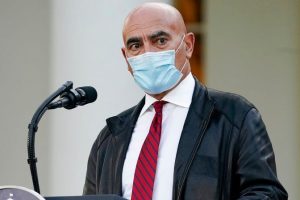Moncef Slaoui is joining Centessa, a new drug company backed with $250 million. Here's how the former head of Operation Warp Speed plans to grow it into the next pharma giant.

- Moncef Slaoui has found his next job after leading Operation Warp Speed, the US government’s coronavirus vaccine initiative.
- The longtime pharma exec was named chief scientific officer for Centessa Pharmaceuticals, a newly launched drug company with major ambitions.
- Centessa was formed by merging 10 existing biotechs and has raised $250 million in a Series A round.
- Visit the Business section of Insider for more stories.
Moncef Slaoui is headed back into the drug industry for his next act.
After three decades climbing the research ranks in Big Pharma, Slaoui became a household name in 2020 by co-leading Operation Warp Speed, the Trump administration’s coronavirus vaccine initiative.
Now, the 61-year-old former pharma executive will steer the science at a newly launched drug company called Centessa Pharmaceuticals. Slaoui will serve as chief scientific officer, running Centessa alongside CEO Saurabh Saha, who most recently served as Bristol Myers Squibb senior vice president of research and development.
The company said on Tuesday it has raised $250 million in a Series A round led by General Atlantic and Vida Ventures. The startup was founded by Medicxi, the healthcare VC firm that Slaoui joined in 2017 after spending nearly 30 years at GlaxoSmithKline.
Saha’s and Slaoui’s company is being formed by merging together 10 privately held biotechs, instantly bringing in-house experimental medicines that go after a variety of diseases.
In total, the Cambridge, Massachusetts-based company will develop 15 potential medicines. Each of the 10 companies will focus on their specific programs, while the larger parent company will allow the firms to share a central infrastructure that deals with other functions like manufacturing, clinical operations, and regulatory affairs.
Centessa’s mantra is asset centricity. Its name is an amalgamation of “centricity” and the word “asset” spelled backwards. Slaoui said he hopes Centessa’s unique, asset-focused, approach will prove to be a new model of drug development, particularly as pharmaceutical companies have been less productive in researching and developing new drugs.
“It’s going to be really exciting to demonstrate that this model really does change the odds in the terms of success and outcomes,” Slaoui told Insider.
Centessa is taking the trendy portfolio approach to biotech
Other biotechs have tried to fix the R&D challenges of drug discovery with similar hub-and-spoke structures.
Most notably, BridgeBio and Roivant Sciences have both found success with the portfolio strategy. Since going public in 2019, BridgeBio’s stock price has more than doubled, with the biotech now commanding a market value of $8.5 billion. Biotech entrepreneur Vivek Ramaswamy founded Roivant in 2014, selling five of its subsidiaries (dubbed Vants) to Japan’s Sumitomo Dainippon Pharma for $3 billion at the end of 2019.
The approach also bears similarities to venture-creation firms like Flagship Pioneering and Atlas Venture. These VC firms act as in-house incubator for biotech companies, funding and staffing their own research labs that eventually develop into biotech companies.
Slaoui said Centessa is different by focusing on individual drug programs, rather than building a wide-range technological platform. The model has been discussed for years among Slaoui and fellow Medicxi partner Francesco De Rubertis, who is Centessa’s chairman.
“The idea isn’t new,” Slaoui said. “The energy to materialize it and make it happen really coalesced somewhere in the second half of 2020.”
Saha said he was approached about the opportunity in late 2020, eventually leaving his senior position at Bristol Myers to join in mid-January 2021.
Slaoui said he had been totally wrapped up with the vaccine research going on for Warp Speed, but had a few early morning calls with De Rubertis and Medicxi’s team in late-2020 about the idea. Slaoui has been working effectively full-time on Centessa for the past 10 days or so, as his Warp Speed duties have wound down under the Biden administration.
Saha says the goal is to be one of the world’s top pharmas
Now, Centessa is moving ahead, completing 10 biotech mergers and finalizing its $250 million initial financing since the start of 2021. The company has about 150 employees, and its leaders expect to keep expanding in the coming weeks.
“The bar is higher everyday I talk to him,” Saha said, referring to cofounder De Rubertis. “It goes from $20 billion to $50 billion to $100 billion pharmaceutical company. The message there is to be one of the top pharmaceutical companies eventually in the world. That’s the goal.”
Analysts at McKinsey wrote in January about the growing threat posed to pharma by these portfolio biotechs.
“It could increase competition not only for innovative assets, as mentioned previously, but also for talent,” they wrote.
Centessa’s subsidiary companies that are now being merged together aren’t household names: ApcinteX, Capella BioScience, Janpix, LockBody, Morphogen-IX, Orexia Therapeutics, Palladio Biosciences, PearlRiver Bio, Pega-One, and Z Factor.
These biotechs are focused on designing medicines to fight a range of diseases, including in the areas of cancer, immunology, neuroscience, and blood disorders. The variety should help offset the risky nature of drug development.
“I call it nowhere to hide in the sense that you have one project or program,” Slaoui said. “It either succeeds or fails. It’s so visible, your performance goes up by definition.”
Get the latest coronavirus business & economic impact analysis from Business Insider Intelligence on how COVID-19 is affecting industries.
Source: Read Full Article
